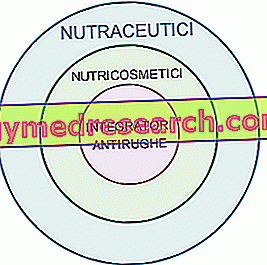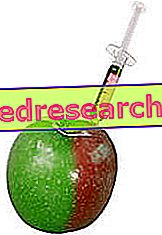Definition
As the name of the disease anticipates, post herpetic neuralgia follows an episode of fire of Saint Anthony (Herpes zoster): we are talking about a neuropathic, burning and acute pain, tending to recur continuously in the same site of attack of the Herpes zoster. Pain can last for months or years.
Causes
Post-herpetic neuralgia is certainly the most common and alarming complication of Herpes zoster: not surprisingly, when Saint Anthony's fire is not treated or underestimated, the chances of contracting neuralgia increase exponentially, given that 'Herpes, slowly but surely, deteriorates the nerves creating damage and pain.
Symptoms
Surely pain is the main symptom that characterizes post-herpetic neuralgia: from most, pain is defined as burning, continuous or intermittent, explosive, localized in a precise and implacable area. However, it is important to remember that pain is subjective and its intensity is perceived differently depending on the severity of the neuralgia: some patients, in fact, only complain of mild paraesthesia and itching, possibly associated with rashes.
Information on drugs for the treatment of post herpetic neuralgia is not intended to replace the direct relationship between health professional and patient. Always consult your doctor and / or specialist before taking Post Herpetic Neuralgia Treatment Drugs.
drugs
Precisely to avoid the degeneration of the shingles in post-herpetic neuralgia, the targeted and immediate pharmacological treatment for the treatment of herpes zoster is essential. In this sense, prevention - once again - turns out to be the best medicine: antiviral drugs, to be taken within the first 3 days of skin lesions (eg Aciclovir, Citarabine, Valaciclovir), are certainly the most effective solution . To learn more: see article dedicated to the care of the fire of Saint Anthony.
The antiviral drugs for the treatment of Herpes zoster ensure full effectiveness when taken within 48-72 hours after the onset of skin rash: if pharmacological treatment is undertaken after this time, complete protection from post-neuralgia would no longer be guaranteed -erpetica.
In the case of post-herpetic neuralgia, the doctor has the duty to prescribe, first of all, a pain-relieving therapy, aimed at calming the burning pain complained of by the patient; in some cases, it is even possible to reach neuronal blockade. Often, the use of a single drug is not sufficient to calm the pain, therefore a combination of drugs is recommended (systemic action + topical application), able to accelerate healing.
The following are the classes of drugs most used in therapy against post-herpetic neuralgia, and some examples of pharmacological specialties; it is up to the doctor to choose the most suitable active ingredient and posology for the patient, based on the severity of the disease, the health status of the patient and his response to treatment:
Anticonvulsant drugs : in addition to the treatment of convulsions, these drugs - given their marked ability to calm pain on damaged nerves - are widely used in therapy against post-herpetic neuralgia.
- Gabapentin (eg. Gabapentin, Apentin, Gabexine, Neurontin) the drug is particularly indicated in the context of post herpetic neuralgia. The dosage should be carefully modified by the doctor, day by day: generally, the first day of therapy is started by taking 300 mg of drug orally once a day, and then taking a double dose on the second day. On the third day, it is recommended to take the drug three times a day. The dose can be increased up to 1800 mg / day. The maintenance dose foresees taking the drug at a dose of 900-1800 mg per day, orally, in 3 divided doses throughout the day.
- Pregabalin (eg LYRICA) the drug is an analogue of amino butyric acid, useful for the treatment of post-herpetic neuralgia. This drug should also be taken in the manner described above, increasing or in any case modifying the dosage based on the severity of the neuralgia. Begin therapy with 75 mg of drug twice a day (or 50 mg every 8 hours); the dose can be increased up to 100 mg three times a day. Patients who do not enjoy any benefit after a month of treatment can take the drug at higher doses (300 mg / 2 times a day or 200 mg / 3 times a day). Always consult your doctor before changing the dosage.
Local anesthetics:
- Lidocaine patches / ointments (eg Lidoc C, Orthodermine, Elidoxil) also used to calm the itching in the context of post-herpetic neuralgia. Apply a layer of cream or ointment in the painful skin area: repeat the application 3-4 times a day, as needed. Alternatively, apply up to 3 patches every 12 hours, trying to cover the painful part only when intact. Remove the patch in case of burning or irritation; the patches are widely used as a therapeutic aid to relieve pain in the context of post-herpetic neuralgia.
Painkillers / opioids : analgesics cannot be missing from the list of possible pain-relieving drugs. Generally, the use of Ibuprofen or paracetamol (in case of fever) is sufficient. In the case of atrocious and relentless pain, more powerful drugs are recommended, such as codeine or hydrocodone.
- Ibuprofen (eg. Brufen, Moment, Subitene): take an active dose of 200-400 mg (tablets, effervescent sachets) every 4-6 hours, as needed. In some cases, the analgesic can also be taken intravenously at a dose of 400-800 mg every 6 hours, as needed.
- Acetylsalicylic acid (eg aspirin, Vivin, Ac Acet, Carin): it is recommended to take a drug dose of 325-650 mg per day, orally or rectally every 4 hours, as needed. Do not exceed 4 g per day. Do not administer to children under the age of 12: the dose is reserved for adults only.
- Paracetamol (or acetaminophen, eg Tachipirina, Buscopan Compositum) for acute pain in the context of post-herpetic neuralgia, associated with alteration of body temperature. Taken orally in the form of tablets, syrup, effervescent sachets, or suppositories, the drug is generally administered at a dose of 325 - 650 mg every 4-6 hours for 6-8 consecutive days, to bring down the fever.
- Capsaicin: a capsaicin-based cream / ointment at 0.025-0.075% seems a good aid to relieve neuropathic pain. It is recommended to apply a layer of cream directly on the sore skin 2-4 times during the 24 hours: do not remove the cream until completely absorbed. It is not recommended to apply the cream less than twice a day: in this case, the therapy would not be effective.
- Codeine (eg. Codein, Hederix Plan) in general, it is recommended to start therapy by taking 30 mg of drug (opioid analgesic) every 6 hours, or as needed. The drug can also be taken intramuscularly or subcutaneously. In case of severity, increase the dose up to 60 mg every 4 hours. Consult your doctor.
- Hydrocodone (eg Vicodin) the dosage must be adjusted according to the severity of the pain and the response of the patient. Generally, one tablet is prescribed every 4-6 hours: never exceed 5 tablets per day.
- Tramadol (eg. Tralenil, Tramadolo, Fortradol) the dose should be established by the doctor based on the intensity of the pain in the context of post-herpetic neuralgia (posology variable from 25 to 400 mg per day. Consult the doctor)
Tricyclic antidepressants : when the disease manifests itself in a violent way, and the patient does not respond positively to the pharmacological treatment described above, the use of antidepressants may be necessary: not by chance, a violent and unstoppable pain, typical of acute neuralgia, can also generate marked changes in mood, irritability and difficulty in falling asleep. Tricyclic antidepressants, in particular, have been shown to be effective in treating neuropathic pain. Generally, these drugs should be taken in small doses, subject to medical prescription.
- Amitriptyline (eg Laroxyl, Triptizol, Adepril) besides being an antidepressant drug, amitriptyline is used in therapy for the treatment of neuropathic pain
- Nortriptyline (eg Dominans, Noritren) the dosage and duration of therapy should be established by the doctor on the basis of pain and its response to treatment (in general, the drug should be administered from 10 to 150 mg per day, depending on the condition of patient's health).
- Maprotiline (eg Ludiomil) also in this case, the dosage with which this antidepressant drug is taken in the context of post-herpetic neuralgia must be established by the doctor after accurate diagnosis of the patient. In general, the substance should be taken at a dose of 75 mg per day.
Prevention of post herpetic neuralgia
Given that the elderly are the preferred targets of Saint Anthony's fire, vaccination is particularly recommended for those patients who have crossed the threshold of 60 years. Strictly speaking, the "ZOSTAVAX" vaccine (active ingredient: attenuated varicella-zoster virus) seems to benefit not only to ensure a certain protection from the Herpes zoster virus, but also to avoid its degeneration in the most formidable complications.
The risk of evolution of shingles in post-herpetic neuralgia in vaccinated patients seems to be reduced by half in those subjects who underwent the prophylactic vaccination just described.



